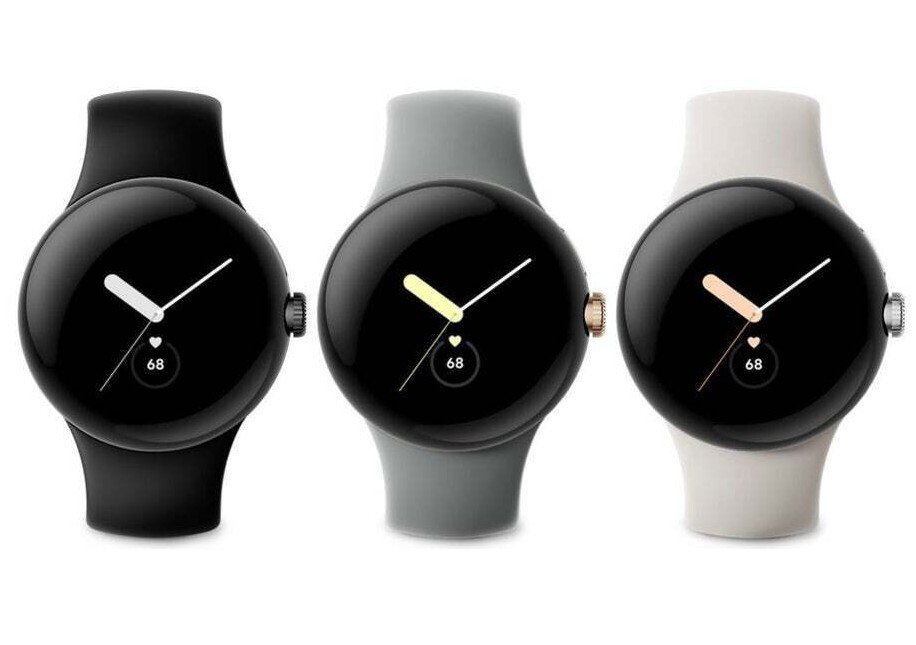After years of speculation and anticipation, Google finally entered the smartwatch arena with its own branded hardware in October 2022: the Google Pixel Watch. This first-generation device wasn’t just another Wear OS watch; it was Google’s statement piece, showcasing a unique design philosophy and leveraging the newly acquired expertise of Fitbit to create a holistic smart and health-focused experience for Android users.
Design: A Bold, Minimalist Statement

The Pixel Watch immediately stood out with its design:
- Distinctive Shape: It featured a beautiful, circular 41mm case made from 80% recycled stainless steel, topped with a custom 3D Corning Gorilla Glass 5 display that domed and curved seamlessly into the body, resembling a smooth pebble or water droplet. This eliminated sharp edges and aimed for maximum comfort.
- Elegant Interaction: Interaction was handled via the responsive touchscreen, a tactile rotating crown with haptic feedback (inspired by classic watches), and a discreet side button nestled near the crown.
- Proprietary Bands: Google introduced a unique twist-and-lock mechanism for swapping bands, ensuring a secure fit and clean integration with the watch case, though limiting initial third-party band compatibility.
- Finishes: It launched in several case/band combinations: Matte Black stainless steel with an Obsidian Active band, Polished Silver with Charcoal or Chalk Active bands, and Champagne Gold with a Hazel Active band.
- Durability: Offered 5 ATM water resistance, making it suitable for swimming in shallow water.
Hardware: Capable Core, Familiar Chip
Inside the elegant exterior, the first-gen Pixel Watch packed:
- Processor: It ran on a Samsung Exynos 9110 SoC, paired with a Cortex M33 co-processor for low-power tasks. Critically, the Exynos 9110 was a chip dating back to 2018, which raised some eyebrows regarding performance and efficiency compared to newer smartwatch processors available at the time.
- Memory & Storage: Despite the older chip, Google equipped it with a generous 2GB of RAM (ensuring smooth UI performance) and 32GB of eMMC storage for apps and offline music/podcasts.
- Display: The bright AMOLED display (~1.2-inch visible area) offered vibrant colors (DCI-P3) and deep blacks, with a peak brightness of up to 1000 nits and an Always-on display option. However, relatively thick bezels surrounded the active display area, which Google cleverly disguised with predominantly dark watch faces and UI elements.
- Sensors Galore: Packed a comprehensive sensor suite including an optical heart rate sensor, a multipurpose electrical sensor for the ECG app, a blood oxygen (SpO2) sensor (activated later via software update), compass, altimeter, accelerometer, gyroscope, and ambient light sensor.
- Connectivity: Included Wi-Fi (2.4GHz only), Bluetooth 5.0, NFC for Google Wallet payments, and GPS. An optional LTE model was available for phone-free connectivity.
- Battery & Charging: Featured a 294mAh battery. Google claimed “up to 24 hours” of battery life, but real-world usage, especially with the Always-on display enabled or extensive GPS/workout tracking, often meant it required charging daily. It used a proprietary magnetic USB-C charging puck, with charging speeds slower than some competitors (~75-80 minutes for 80%, ~110 mins for 100%).
Software: Wear OS 3.5 Meets Fitbit
The Pixel Watch launched with Wear OS 3.5, offering a fluid and refined user interface combined with deep health integration:
- Fitbit Integration: This was a key selling point. Users could track steps, continuous heart rate, sleep stages and score, Active Zone Minutes, calories burned, and over 40 workout types. The ECG app allowed for on-demand heart rhythm assessment for signs of AFib, and SpO2 tracking provided insights during sleep. All data synced seamlessly with the Fitbit app on the paired Android phone. A 6-month trial of Fitbit Premium was included.
- Google Services: Provided seamless access to Google Assistant, Google Wallet, Google Maps turn-by-turn navigation, Google Calendar/Gmail notifications, YouTube Music playback, and Google Home smart device control.
- Safety Features: Included Fall Detection and Emergency SOS (using the side button or Assistant). The LTE version also supported international emergency calling.
Reception and Legacy: A Beautiful Beginning with Caveats
The first-generation Pixel Watch received generally positive reviews, particularly for its stunning and unique design, comfortable wearability, smooth software performance, and excellent integration of Fitbit’s health tracking features. It successfully established Google’s vision for a first-party Wear OS device.
However, it wasn’t without criticism. The mediocre battery life was the most common complaint, often failing to reliably last a full 24 hours with moderate use. The use of the aging Exynos 9110 processor, while performing adequately thanks to sufficient RAM, felt like a missed opportunity. The large display bezels (though well hidden) and the proprietary band system also drew some negative comments.
Despite these drawbacks, the original Pixel Watch was a significant launch. It finally brought a “Google Watch” to market, set a high bar for smartwatch design elegance, and successfully merged the Wear OS ecosystem with Fitbit’s powerful health platform, paving the way for future iterations.
